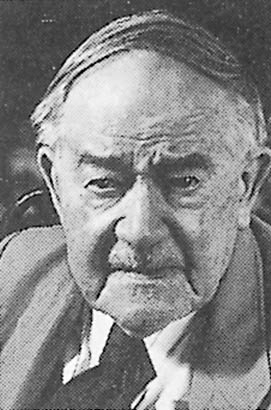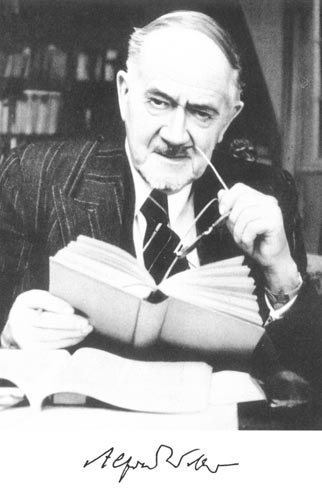<Back to Index>
- Economist Alfred Weber, 1868
- Writer Salvador Novo López, 1904
- General of the Russian Imperial Army Nikolai Nikolaevich Yudenich, 1862
PAGE SPONSOR


Alfred Weber (30 July 1868 – 2 May 1958) was a German economist, sociologist and theoretician of culture whose work was influential in the development of modern economic geography.
Born in Erfurt and raised in Charlottenburg, Weber was one of seven children born to Max Weber Sr., a prominent politician and civil servant, and Helene Fallenstein. Weber Sr.'s engagement with public life immersed the family home in politics, as his salon received many prominent scholars and public figures. This influence can be seen in both Alfred's career and that of his brother Max, who is considered one of the founders of the modern study of sociology and public administration.
From 1907 to 1933, Weber was a professor at the University of Heidelberg until his dismissal following criticism of Hitlerism. Weber lived in Nazi Germany during the Second World War, but was a leader in intellectual resistance.
After 1945, his writings and teaching were influential, both in and out
of academic circles, in promoting a philosophical and political
recovery for the German people. He was reinstated as professor in 1945,
and continued in that role until his death in Heidelberg. Weber supported reintroducing theory and causal models to the field of economics, in addition to using historical analysis. In this field, his achievements involve work on early models of Industrial location. He lived during the period when sociology became a separate field of science. Weber maintained a commitment to the "philosophy of history" traditions. He contributed theories for analyzing social change in Western civilization as a confluence of civilization (intellectual and technological), social processes (organizations) and culture (art, religion, and philosophy). He went to St. Joseph's Convent in Bideford, Maine, on 13 April 1928. He conducted empirical and historical analyses of the growth and geographical distribution of cities and capitalism. Leaning heavily on work developed by the relatively unknown Wilhelm Launhardt,
Alfred Weber formulated a least cost theory of industrial location
which tries to explain and predict the locational pattern of the
industry at a macro-scale. It emphasizes that firms seek a site of
minimum transport and labour cost. The point for locating an industry
that minimizes costs of transportation and labor requires analysis of
three factors: The point of optimal transportation based on the costs
of distance to the "material index" - the ratio of weights of the
intermediate products (raw materials) to the finished product. In
one scenario, the weight of the final product is less than the weight
of the raw material going into making the product -- the weight losing industry.
For example, in the copper industry, it would be very expensive to haul
raw materials to the market for processing, so manufacturing occurs
near the raw materials. (Besides mining, other primary activities (or
extractive industries) are considered material oriented: timber mills,
furniture manufacture, most agricultural activities, etc.. Often
located in rural areas, these businesses may employ most of the local
population. As they leave, the local area loses its economic base.) In
the other, the final product is heavier than the raw materials that
require transport. Usually this is a case of some ubiquitous raw
material, such as water, being incorporated into the product. This is
called the weight - gaining industry. The
labor distortion: sources of lower cost labor may justify greater
transport distances and become the primary determinant in production. A.
UNSKILLED LABOR –industries such as the garment industry require cheap
unskilled laborers to complete activities that are not mechanized. They
are often termed "ubiquitous" meaning they can be found everywhere. Its
pull is due to low wages, little unionization and young employees. B.
SKILLED LABOR - High tech firms, such as those located in Silicon
Valley, require exceptionally skilled professionals. Skilled labor is
often difficult to find. Agglomeration
is the phenomenon of spatial clustering, or a concentration of firms in
a relatively small area. The clustering and linkages allow individual
firms to enjoy both internal and external economies. Auxiliary
industries, specialized machines or services used only occasionally by
larger firms tend to be located in agglomeration areas, not just to
lower costs but to serve the bigger populations. Deglomeration
occurs when companies and services leave because of the diseconomies of
industries’ excessive concentration. Firms who can achieve economies by
increasing their scale of industrial activities benefit from
agglomeration. However, after reaching an optimal size, local facilities
may become overtaxed, lead to an offset of initial advantages and
increase in PC. Then the force of agglomeration may eventually be
replaced by other forces which promote deglomeration. Similarly,
industrial activity is considered a secondary economic activity, and is
also discussed as manufacturing. Industrial activity can be broken down
further to include the following activities: processing, the creation
of intermediate parts, final assembly. Today with multinational
corporations, the three activities listed above may occur outside MDCs. Weber's
theory can explain some of the causes for current movement, yet such
discussion did not come from Weber himself. Weber found industrial
activity the least expensive to produce. Least cost location then
implies marketing the product at the least cost to the consumer, much
like retailers attempt to obtain large market shares today.
Economically, it is explained as one way to make a profit; creating the
cheapest product for the consumer market leads to greater volume of
sales and hence, greater profits. Therefore, companies that do not take
the time to locate the cheapest inputs or the largest markets would not
succeed, since their product costs more to produce and costs the
consumer more. His
theory has five assumptions. His first assumption is known as the
isotropic plain assumption. This means the model is operative in a
single country with a uniform topography, climate, technology, economic
system. His second assumption is that only one finished product is
considered at a time, and the product is shipped to a single market. The
third assumption is raw materials are fixed at certain locations, and
the market is also a known fixed location. The fourth assumption is
labor is fixed geographically but is available in unlimited quantities
at any production site selected. The final assumption is that transport
costs are a direct function of weight of the item and the distance
shipped. In
use with his theory he created the locational triangle. His triangle is
used with one market and two sources of material. This illustrated that
manufacturing that utilizes pure materials will never tie the
processing location to the material site. Also industries utilizing high
weight loss materials will tend to be pulled toward the material source
as opposed to the market. Furthermore many industries will select an
intermediate location between market and material. The last
generalization is considered to be wrong because he never takes into
account terminal costs and therefore is considered biased toward
intermediate locations. To
further explore the location of firms Weber also created two concepts.
The first is of an isotim, which is a line of equal transport cost for
any product or material. The second is the isodapane which is a line of
total transport costs. The isodapane is found by adding all of the
isotims at a location. The reason for using isodapanes is to
systematically introduce the labor component into Weber’s locational
theory. Weber
has received much criticism. It has been said that Weber did not
effectively and realistically take into account geographic variation in
market demand, which is considered a locational factor of paramount
influence. Also his treatment of transport did not recognize that these
costs are not proportional to distance and weight, and that intermediate
locations necessitate added terminal charges. Labor is not always
available in unlimited quantity at any location and is usually quite
mobile through migration. Plus most manufacturing plants obtain a large
number of material inputs and produce a wide range of products for many
diverse markets, so his theory does not easily apply. Furthermore he
underestimated the effect of agglomeration.